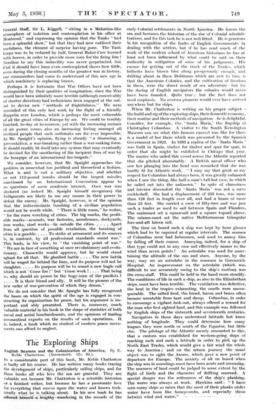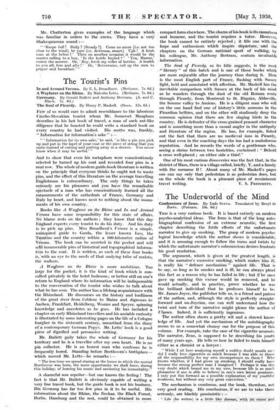The Exploring Ships
English Seamen and the Colonization of America. By E. Keb1e Chatterton. (-knowsmith. 12s. 6d.).
IN a considerable part of this book, .Mr. Keble Chatterton is badly off his course. He has written many books tracing the development of shim., :pattiCularly sailing ships, and for these books all who loVe the sea are grateful. They are Valuable not because Mr. Chatterton is a scientific historian or a finished writer, but because he has a - passionate- love for everything that moves upon the water and knows tech- nically what he is talking about. In • his new .book he has allirived--a:lengihy•:-vrandering in the records of the
. . early Colonial-settlements -in • North- Anierical He leaves the
sea and bedomes the historian of the rise of Colonial adminis- trations, and for this task he is not well fitted. He is generous in his recognition of the faults of English Governments in dealing with the settlers, but if he has read much of the work of. the modern school of American historians he has at least not been influenced by what could be said on their authority in mitigation of some of his judgments. His :excuse for getting out of the track of the Trades, which hitherto have blown him along prosperously enough, and drifting about M these Doldrums which are. new to him, is that the American Colonies, and the cultivation of freedom in them, were the direct result of sea adventure—but for the daring of English navigators the colonies would never have been founded. Quite true ; -but the fact does . not need emphasis. No oversea pioneers would ever have arrived anywhere but for Ships.
When Mr. Chatterton is writing on his proper subject— the build and rig of the exploring ships, their domestic economy, their routine and their methods of navigation—he is delightful. Consider, for example, the Santa Maria,' the flagship of
Christopher Columbus. A visitor to the South Kensington Museum can see what this famous caravel was like for there is a model of her there which was presented by the Spanish Government in 1923. In 1893 a replica of the Santa Maria' was built in Spain, timber for timber and spar for spar, in order that she might be exhibited in Chicago that year. The master who sailed this vessel across the Atlantic reported that she pitched abominably. A British naval officer who saw her plunging into the head seas remarked that she was hardly fit for Atlantic work. "I may say that great as my respect for Columbus had always been, it was greatly enhanced when I saw the thing, like half a man's tall-hat case, in which he sailed out into the unknown." In spite of clumsiness and interior discomfort the Santa Maria' was not a niere cockleshell. She had a displacement of 233 tons, was more than 128 feet in length over all, and had a beam of more than 25 feet. She carried a crew of fifty-two and was just such a trader as used to sail between Spain and Flanders. The mainmast set a squarcsail and a square topsail above. The mizzen-ma.st set the native Mediterranean triangular fore-and-aft lateen sail.
The time on board such a ship was kept by hour glasses which had to be capsized at regular intervals. The seamen of Columbus were bad helmsmen, and used to annoy him by falling off their course. Annoying, indeed, for a ship- of that type could not in any case sail effectively nearer to' the wind than seven points! An astrolabe was used for ascer- taining the altitude. of the sun and stars. Anyone, by the way, may see an astrolabe in the museum in Greenwich Hospital. An improvement on the astrolabe (which was difficult to use accurately owing to the ship's motion) was the cross-staff. This could be held in the hand more steadily. The conditions of life in such a ship, as also in the Elizabethan ships, must have been terrible. The ventilation was defective, the heat in the tropics exhausting, the smells were uncon- querable. The salted food, the bread, bacon and beans often became uneatable from heat and damp. • Columbus, in order to encourage a vigilant look-out, always offered a reward for the man who first sighted land, and this example was followed by English ships of the Sixteenth and seventeenth centuries.
Navigators in those days understood latitude but knew nothing of longitude. They could determine how ninny leagues they were north or south of the Equator, but little else. The pilotage of the Atlantic merely amounted to this, that a custom was established for western-going ships of reaching. such and such a latitude in order to pick up 'the North East Trades, which would give a fair wind the whole way to America ; and on the return journey the Usual object was to sight the Azores, which gave a new point of departure for Europe. The anxiety of all on board' when the ship was in soundings must have been acute and unceasing. The nearness of land could be judged to some extent by* the flight of birds and the character of drifting seaweed., . A special danger was the rottenness of the ship's planking. The worm was always at work. Hawkins said : " -hive seen many ships so eaten that the most of their planks uhder water have been tlike honeycombs, and especially thOse
betwixt wind' and water." • • — Mr- Chatterton gives examples of the language which was familiar in orders to the crews. They have a very Shakespearean sound :—
" Keepe full ! Stidy ! [Steady !]. Come no neere [i.e. not too close to the wind), be yare [i.e. dextrous, smart]. Ugh ! A fresh man at the helme ! ' Then on another occasion it would be the master calling to a boy, 'Is the kettle boyled " Yea; Master,' comes the answer. Or, Boy, fetch my celler Of bottles. A health to you all, fore and afte ! ' Or, Boteswaine, call up the men to
prayer and breakfast.'" -















































 Previous page
Previous page